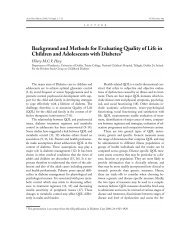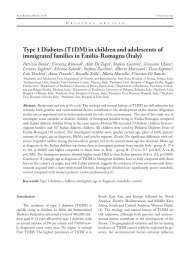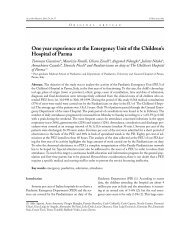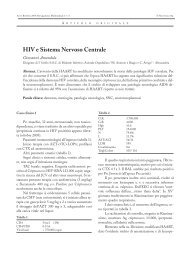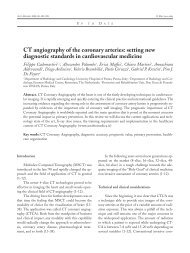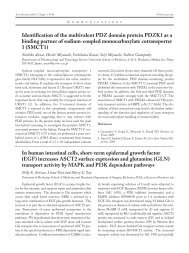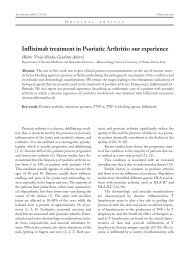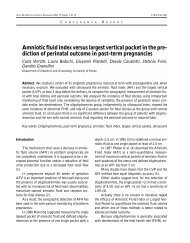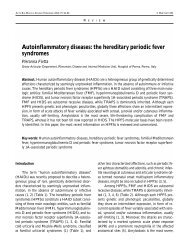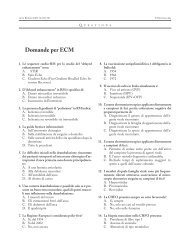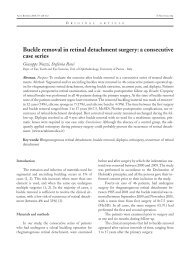Contribution of studies on renal effects of heavy metals and selected ...
Contribution of studies on renal effects of heavy metals and selected ...
Contribution of studies on renal effects of heavy metals and selected ...
Create successful ePaper yourself
Turn your PDF publications into a flip-book with our unique Google optimized e-Paper software.
64 I. Franchini, R. Alinovi, E. Bergamaschi, A. Mutti<br />
few hours up to a few years. Mice, guinea pigs, dogs,<br />
primates, <strong>and</strong> female rats do not develop the lesi<strong>on</strong>. It<br />
is not known if similar morphologic tubular damage<br />
occurs in humans exposed to gasoline vapors. The hydrocarb<strong>on</strong>s<br />
studied in animal models include n-<br />
n<strong>on</strong>ane, C8, C10-C11 isoparaffinic solvent, jet fuels,<br />
methyl-isobutyl ket<strong>on</strong>e, varnish, unleaded gasoline,<br />
naphthas, <strong>and</strong> a variety <str<strong>on</strong>g>of</str<strong>on</strong>g> complex organic solvents<br />
<strong>and</strong> distillates. These volatile hydrocarb<strong>on</strong>s are cytotoxic<br />
to proximal tubules, where they <strong>and</strong> their metabolic<br />
products are selectively accumulated. The most<br />
prominent lesi<strong>on</strong> is hyaline droplet formati<strong>on</strong> within<br />
epithelial cells <str<strong>on</strong>g>of</str<strong>on</strong>g> proximal tubules. Sustained <strong>renal</strong><br />
failure with permanently reduced GFR has not been<br />
reported in light hydrocarb<strong>on</strong> nephropathy in humans<br />
or experimental animals.<br />
Experimental exposure to hydrocarb<strong>on</strong>s has sporadically<br />
produced glomerular lesi<strong>on</strong>s, but this has generally<br />
occurred as a c<strong>on</strong>sequence <str<strong>on</strong>g>of</str<strong>on</strong>g> tubulo-interstitial<br />
damage. Although the role <str<strong>on</strong>g>of</str<strong>on</strong>g> tubulo-interstitial injury<br />
in now recognized as a key factor in the progressi<strong>on</strong> <str<strong>on</strong>g>of</str<strong>on</strong>g><br />
<strong>renal</strong> diseases, the relevance <str<strong>on</strong>g>of</str<strong>on</strong>g> these models to the human<br />
beings is questi<strong>on</strong>able, owing to the overt differences<br />
in biotransformati<strong>on</strong> <strong>and</strong> in the delivery <str<strong>on</strong>g>of</str<strong>on</strong>g> solvent<br />
metabolites to the kidney. Some metabolites <str<strong>on</strong>g>of</str<strong>on</strong>g><br />
compounds bel<strong>on</strong>ging to different classes <str<strong>on</strong>g>of</str<strong>on</strong>g> organic<br />
solvents are able to bind the rat specific protein α 2 -microglobulin<br />
<strong>and</strong> accumulate in proximal tubules, where<br />
the complex tends to precipitate in the form <str<strong>on</strong>g>of</str<strong>on</strong>g> insoluble<br />
crystals, eventually leading to cell degenerati<strong>on</strong> <strong>and</strong><br />
death. In a rat model <str<strong>on</strong>g>of</str<strong>on</strong>g> perchloroethylene (PCE)-induced<br />
nephropathy, the tubular accumulati<strong>on</strong> <str<strong>on</strong>g>of</str<strong>on</strong>g> α 2 -<br />
microglobulin precipitating in the form <str<strong>on</strong>g>of</str<strong>on</strong>g> insoluble<br />
crystals in male rats exposed to PCE for 4 weeks gave<br />
rise to selective damage to S2 tract <str<strong>on</strong>g>of</str<strong>on</strong>g> proximal tubules<br />
<strong>and</strong> its amount was correlated with albuminuria, a<br />
widely accepted biomarker <str<strong>on</strong>g>of</str<strong>on</strong>g> glomerular dysfuncti<strong>on</strong><br />
(53). α 2 -Microglobulin is also present at very low c<strong>on</strong>centrati<strong>on</strong>s<br />
in female rats, which doesn’t develop overt<br />
<strong>renal</strong> damage but <strong>on</strong>ly minor changes, <strong>and</strong> it is lacking<br />
in human beings. Smaller but significant increases in<br />
albuminuria, associated with low molecular weight<br />
proteinuria (RBP <strong>and</strong> β 2 -microglobulin) were found in<br />
female rats. Thus, in the above model, exposure to<br />
PCE seems to determine glomerular proteinuria <str<strong>on</strong>g>of</str<strong>on</strong>g><br />
tubular origin (53).<br />
Many investigators have attempted to identify<br />
solvent-induced glomerul<strong>on</strong>ephritis by assessing the<br />
urine <str<strong>on</strong>g>of</str<strong>on</strong>g> exposed workers for low-molecular-weight<br />
proteins <strong>and</strong> enzymes, markers for tubular, rather than<br />
glomerular disease (54, 55). Cross-secti<strong>on</strong>al <str<strong>on</strong>g>studies</str<strong>on</strong>g><br />
carried out in groups <str<strong>on</strong>g>of</str<strong>on</strong>g> workers occupati<strong>on</strong>ally exposed<br />
to solvent mixtures <strong>and</strong> perchloroethylene in<br />
dry-cleaning shops has shown mild functi<strong>on</strong>al<br />
changes suggesting diffuse abnormalities al<strong>on</strong>g the<br />
nephr<strong>on</strong>. Possible generalized membrane alterati<strong>on</strong>s<br />
can be resp<strong>on</strong>sible <str<strong>on</strong>g>of</str<strong>on</strong>g> the observed increase in high<br />
molecular weight proteinuria, fibr<strong>on</strong>ectin <strong>and</strong> brushborder<br />
antigens (56). Although such tubular proteinuria<br />
is comm<strong>on</strong>, the massive albuminuria <str<strong>on</strong>g>of</str<strong>on</strong>g> solvent<br />
nephropathy is distinctly rare in associati<strong>on</strong> with perchloroethylene<br />
exposure.<br />
Case-c<strong>on</strong>trol <str<strong>on</strong>g>studies</str<strong>on</strong>g> suggest a possible role <str<strong>on</strong>g>of</str<strong>on</strong>g> exposure<br />
to volatile hydrocarb<strong>on</strong>s not <strong>on</strong>ly in the development<br />
<str<strong>on</strong>g>of</str<strong>on</strong>g> chr<strong>on</strong>ic glomerul<strong>on</strong>ephritis, but also in<br />
their progressi<strong>on</strong> towards end-stage <strong>renal</strong> disease (57,<br />
58). In spite <str<strong>on</strong>g>of</str<strong>on</strong>g> the difficulty to implement experimental<br />
models <str<strong>on</strong>g>of</str<strong>on</strong>g> multifactorial diseases, for which the<br />
interacti<strong>on</strong> between risk factors seems more relevant<br />
than a sum <str<strong>on</strong>g>of</str<strong>on</strong>g> single effect produced by each <strong>on</strong>e, we<br />
recently evaluated the role <str<strong>on</strong>g>of</str<strong>on</strong>g> styrene, a widely used<br />
hydrocarb<strong>on</strong>, in the progressi<strong>on</strong> <str<strong>on</strong>g>of</str<strong>on</strong>g> a well know<br />
nephropathy (59). Adriamycin-induced nephrosis was<br />
chosen as a model because it is characterized by progressive<br />
worsening <str<strong>on</strong>g>of</str<strong>on</strong>g> proteinuria, followed by focal<br />
glomerulosclerosis <strong>and</strong> tubulo-interstitial fibrosis (60).<br />
Co-exposure to ADR <strong>and</strong> styrene resulted in a proteinuria<br />
much greater than that caused by ADR al<strong>on</strong>e.<br />
The interactive effect <str<strong>on</strong>g>of</str<strong>on</strong>g> styrene <strong>and</strong> ADR was statistically<br />
significant for albuminuria <strong>and</strong> urinary fibr<strong>on</strong>ectin.<br />
A similar resp<strong>on</strong>se was observed for GFR<br />
at the end <str<strong>on</strong>g>of</str<strong>on</strong>g> the experiment, styrene-exposed animals<br />
showing hyperfiltrati<strong>on</strong> as compared to their respective<br />
c<strong>on</strong>trol group. At the end <str<strong>on</strong>g>of</str<strong>on</strong>g> the experiment,<br />
histopathological scoring for interstitial infiltrati<strong>on</strong><br />
<strong>and</strong> fibrosis was also significantly higher in styrenetreated<br />
animals as compared to their respective c<strong>on</strong>trol<br />
groups. In ADR-treated rats, L.M.W proteinuria was<br />
<strong>on</strong>ly slightly affected, suggesting minimal tubular dysfuncti<strong>on</strong><br />
associated with extensive tubular atrophy.<br />
However, styrene-exposed animals showed L.M.W<br />
proteinuria higher than their respective c<strong>on</strong>trols.



